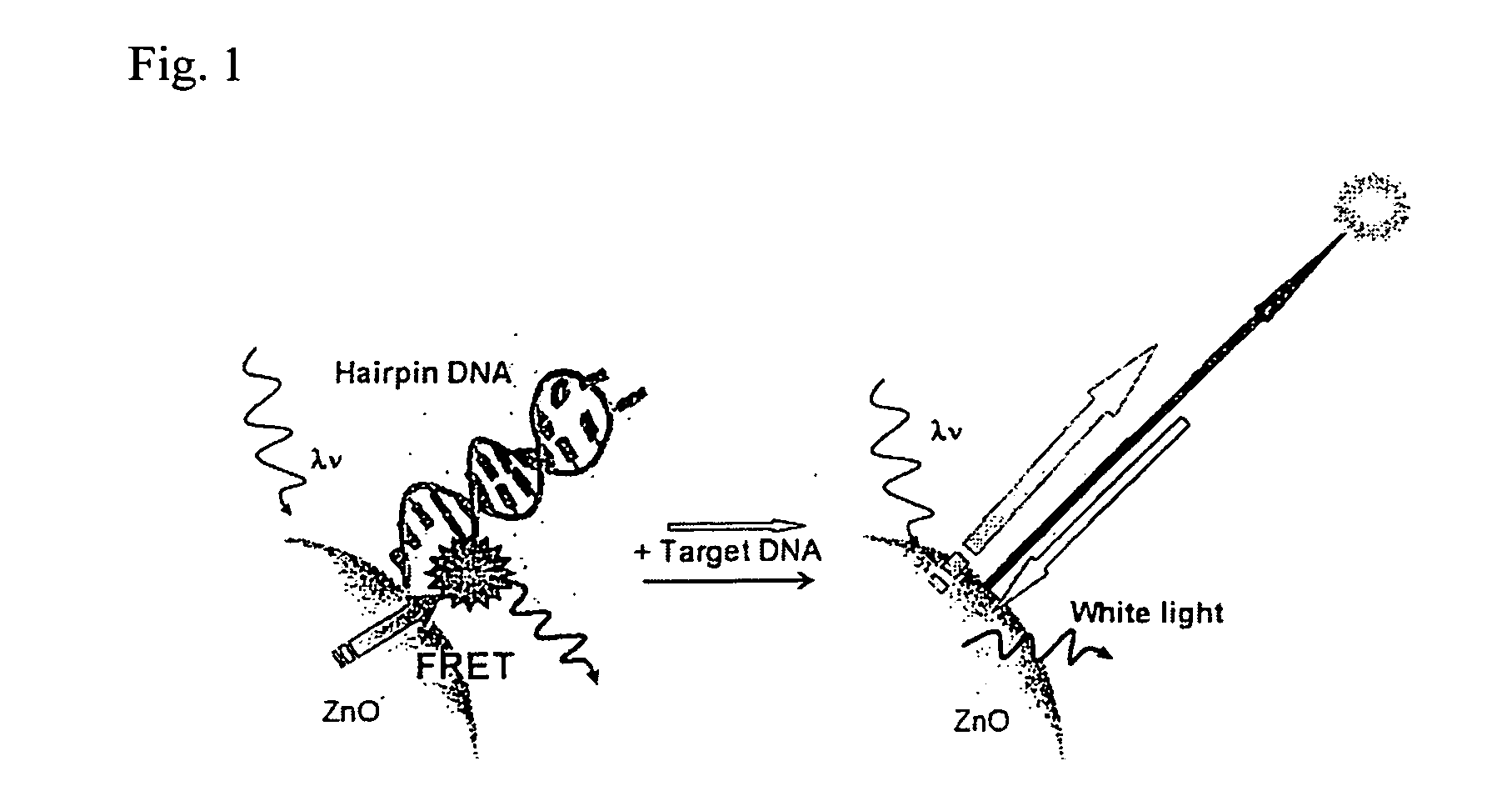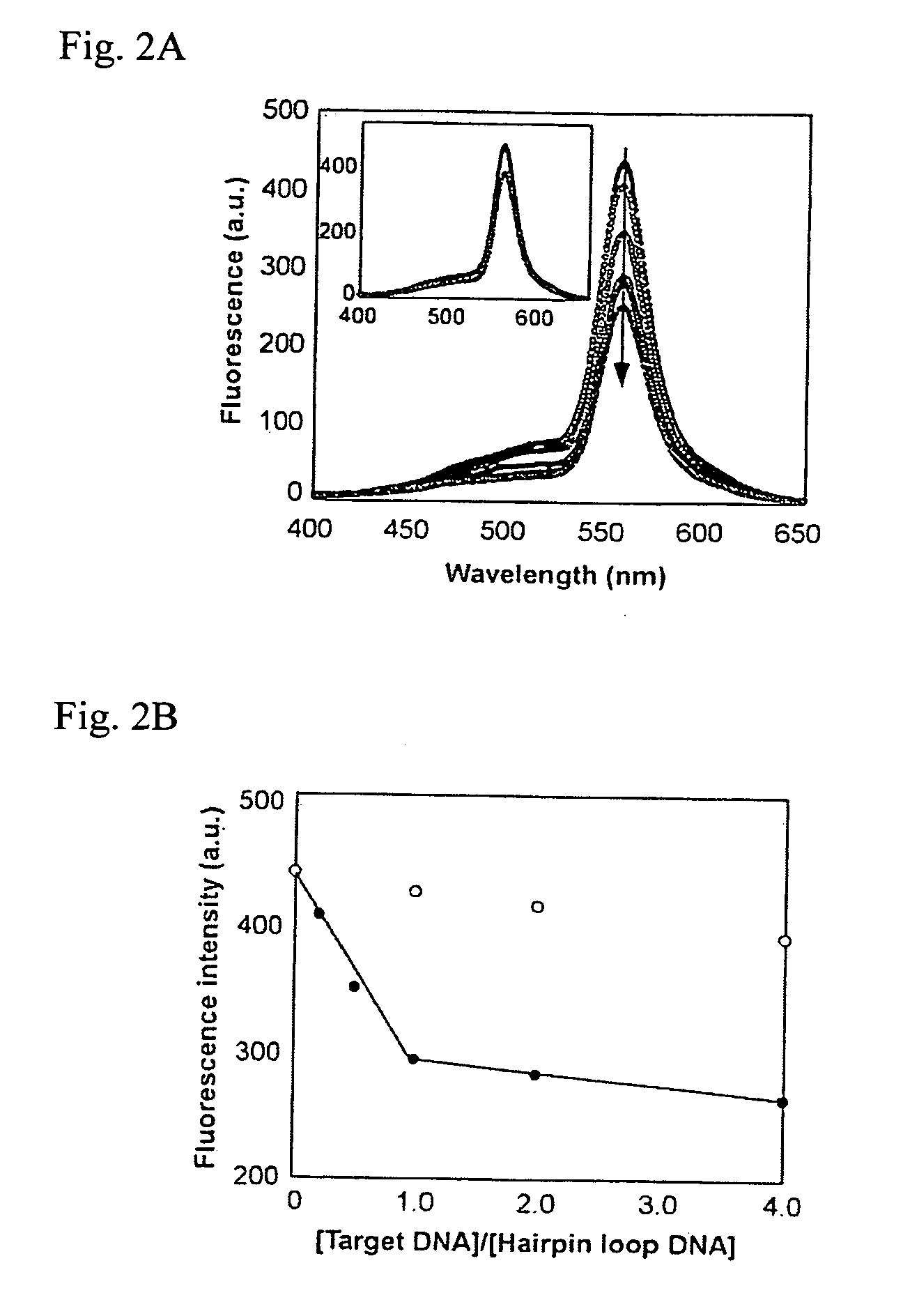Fluorescent probe and fluorescence detecting method
a fluorescence detection and fluorescent probe technology, applied in the field of fluorescent probes and fluorescence detection methods, can solve the problems of quantitative and reproducibility impairment, and achieve the effects of avoiding sensitivity loss, reducing the number of fluorescent dyes, and improving separation of emission from excitation ligh
- Summary
- Abstract
- Description
- Claims
- Application Information
AI Technical Summary
Benefits of technology
Problems solved by technology
Method used
Image
Examples
example 1
Synthesis of Zinc Oxide Nano Particles
[0116] Dehydrated ethanol (250 mL) was added to zinc acetate dihydrate (5.49 g, 25 mmol), and the mixture was mildly heated and refluxed in a Dean-Steark dehydrating apparatus for 2 hours while the solvent was distilled away. The amount of the removed solvent was 150 mL. 150 mL of dehydrated EtOH was added again to the resultant turbid reaction solution, and the solution was heated and refluxed. The reaction solution that became transparent was cooled to room temperature with water.
[0117] To the reaction solution, tetramethyl ammonium hydroxide (25% methanol solution,1 1.4 mL, 28 mmol) was added and the mixture was stirred for 4 hours at room temperature. Then, 3-amino propyl trimethoxy silane (4.7 mL, 25 mmol) and water (1.5 mL, 83.3 mmol) were added thereto, and the resultant mixture was stirred for 4 hours at 60° C. 7 minutes after the start of the reaction, a white solid matter deposited. The reaction solution was cooled to room temperatur...
example 2
Synthesis of Probe Oligonucleotide
[0121] The probe oligonucleotides having the following sequences were manufactured by solid phase synthesis using a known phosphoamidite method.
[0122] HEX is a fluorescent dye having an absorption maximum wavelength of 534 nm and a fluorescence maximum wavelength of 556 nm. In the sequences, the underline indicates the mutation location.
[0123] The probe oligonucleotides were purified by reverse phase column chromatography, and the structures thereof were confirmed by MALDI-TOF mass spectrum.
TABLE 1(a) Hairpin loop DNA(Seq. ID No. 1)5′-H2N-(C6)-ACACGCTCATCATAACCTTCAGCAAGCTTTAACTCATAGTGAGCGTGT-HEX-3′(b) Target DNA(Seq. ID No. 2)5′-ACGCTCACTATGAGTTAAAGCTTGCTGAAGG-TTATGA-3′(c) Single nucleotide polymorphism target DNA(Seq. ID No. 3)5′-ACGCTCACTATGAGTTCAAG-CTTGCTGAAGGTTATGA-3′
example 3
Binding Zinc Oxide Nano Particles to Oligonucleotide
[0124] Zinc oxide nano particles modified with amino groups prepared in Example 1 were dispersed in a solution containing 200 mM of NaCl and 50 mM of HEPES (pH 8) to give a concentration of 150 μM. Succinic anhydride in 10 times as much mole as the zinc oxide particles was added, and the mixture was stirred for 1 hour at room temperature. Then, the mixture was subjected to ultrasonication for 15 minutes, whereby carboxyl groups were introduced onto the particle surface. Excessive succinic anhydride was removed by gel filtration or centrifugal separation.
[0125] Thereafter, the oligonucleotide prepared in example 2 (a), 5 equivalents of N-hydroxy succinimide, and WSC were added thereto, and the reaction was allowed to proceed for 3 hours at room temperature, so that a probe having the donor nano particle fluorescent material linked to the 5′ terminal end and the acceptor dye to the 3′ terminal end was obtained.
PUM
| Property | Measurement | Unit |
|---|---|---|
| Particle size | aaaaa | aaaaa |
| Particle size | aaaaa | aaaaa |
| Wavelength | aaaaa | aaaaa |
Abstract
Description
Claims
Application Information
 Login to View More
Login to View More - R&D
- Intellectual Property
- Life Sciences
- Materials
- Tech Scout
- Unparalleled Data Quality
- Higher Quality Content
- 60% Fewer Hallucinations
Browse by: Latest US Patents, China's latest patents, Technical Efficacy Thesaurus, Application Domain, Technology Topic, Popular Technical Reports.
© 2025 PatSnap. All rights reserved.Legal|Privacy policy|Modern Slavery Act Transparency Statement|Sitemap|About US| Contact US: help@patsnap.com


